Temporal and Spatial Dynamics of Carbon Storage in Qinghai Grasslands
Abstract
:1. Introduction
2. Materials and Methods
2.1. Study Area
2.2. Model Description
2.3. Model Inputs
3. Results
3.1. Model Validation
3.2. Vegetation Carbon
3.3. Soil Organic Carbon
4. Discussion
4.1. Uncertainties in Results
4.2. Spatiotemporal Dynamics of Vegetation Carbon and Soil Organic Carbon
4.3. Comparison of Results with Those from Other Studies
5. Conclusions
Author Contributions
Funding
Institutional Review Board Statement
Informed Consent Statement
Data Availability Statement
Acknowledgments
Conflicts of Interest
Appendix A
| Parameters | <2500 m | 2500–3500 m | 3500–4500 m | >4500 m |
|---|---|---|---|---|
| Yearday to start new growth | 85 * | 110 * | 132 * | 154 * |
| Yearday to end litterfall | 317 * | 290 * | 271 * | 252 * |
| Transfer growth period as fraction of growing season | 1 | 1 | 1 | 1 |
| Litterfall as fraction of growing season | 1 | 1 | 1 | 1 |
| Base temperature | 0 | 0 | 0 | 0 |
| Annual leaf and fine root turnover fraction | 1 | 1 | 1 | 1 |
| Whole-plant mortality fraction in vegetation period | 0.1 | 0.1 | 0.1 | 0.1 |
| C:N of leaves | 12.47 * | 12.47 * | 12.47 * | 12.47 * |
| C:N of leaf litter, after re-translocation | 45.0 * | 45.0 * | 45.0 * | 45.0 * |
| C:N of fine roots | 37.29 * | 37.29 * | 37.29 * | 37.29 * |
| Dry matter carbon content of leaves | 0.4 | 0.4 | 0.4 | 0.4 |
| Dry matter carbon content of leaf litter | 0.4 | 0.4 | 0.4 | 0.4 |
| Dry matter carbon content of fine roots | 0.4 | 0.4 | 0.4 | 0.4 |
| Dry matter carbon content of soft stem | 0.4 | 0.4 | 0.4 | 0.4 |
| All-sided to projected leaf area ratio | 2.0 | 2.0 | 2.0 | 2.0 |
| Ratio of shaded SLA: sunlit SLA | 2.0 | 2.0 | 2.0 | 2.0 |
| Maximum stomatal conductance (projected area basis) | 0.2 m/s | 0.2 m/s | 0.2 m/s | 0.2 m/s |
| Boundary layer conductance (projected area basis) | 0.039 m/s | 0.039 m/s | 0.039 m/s | 0.039 m/s |
| Maximum depth of rooting zone | 1 m | 1 m | 1 m | 1 m |
| Maximum depth of rooting zone | 1 m | 1 m | 1 m | 1 m |
| Root weight corresponding to max root depth | 0.4 kgC | 0.4 kgC | 0.4 kgC | 0.4 kgC |
| Root weight to root length conversion factor | 1000 m/kg | 1000 m/kg | 1000 m/kg | 1000 m/kg |
| Leaf allocation | 0.3 | 0.3 | 0.3 | 0.3 |
| Fine root allocation | 0.52 | 0.52 | 0.52 | 0.52 |
| Soft stem allocation | 0.18 | 0.18 | 0.18 | 0.18 |
| Canopy average specific leaf area (projected area basis) | 24 m2/kgC * | 24 m2/kgC * | 24 m2/kgC * | 24 m2/kgC * |
Appendix B
| Observed Data | Selecting Locations | Sampling Dates | Methods | Sample Sizes |
|---|---|---|---|---|
| VC | Maqin County, | 2008–2015, 2018–2021 | Literature search, field sampling and laboratory analysis | 100 cm × 100 cm, 50 cm × 50 cm |
| Gonghe County, | ||||
| Menyuan County, | ||||
| Maduo County, | ||||
| Guinan County, | ||||
| Chengduo County | ||||
| SOC | Maqin County, | 2010, 2012, 2018–2021 | Literature search, field sampling and laboratory analysis | 100 cm × 100 cm, 50 cm × 50 cm |
| Gonghe County, | ||||
| Menyuan County, | ||||
| Maduo County, | ||||
| Guinan County, | ||||
| Yushu County, | ||||
| Chengduo County, | ||||
| Zhiduo County, | ||||
| Dari County, | ||||
| Gande County, | ||||
| Qumalai County, | ||||
| Qilian County, | ||||
| Tongde County, | ||||
| Zeku County, | ||||
| Gangcha County |
Appendix C
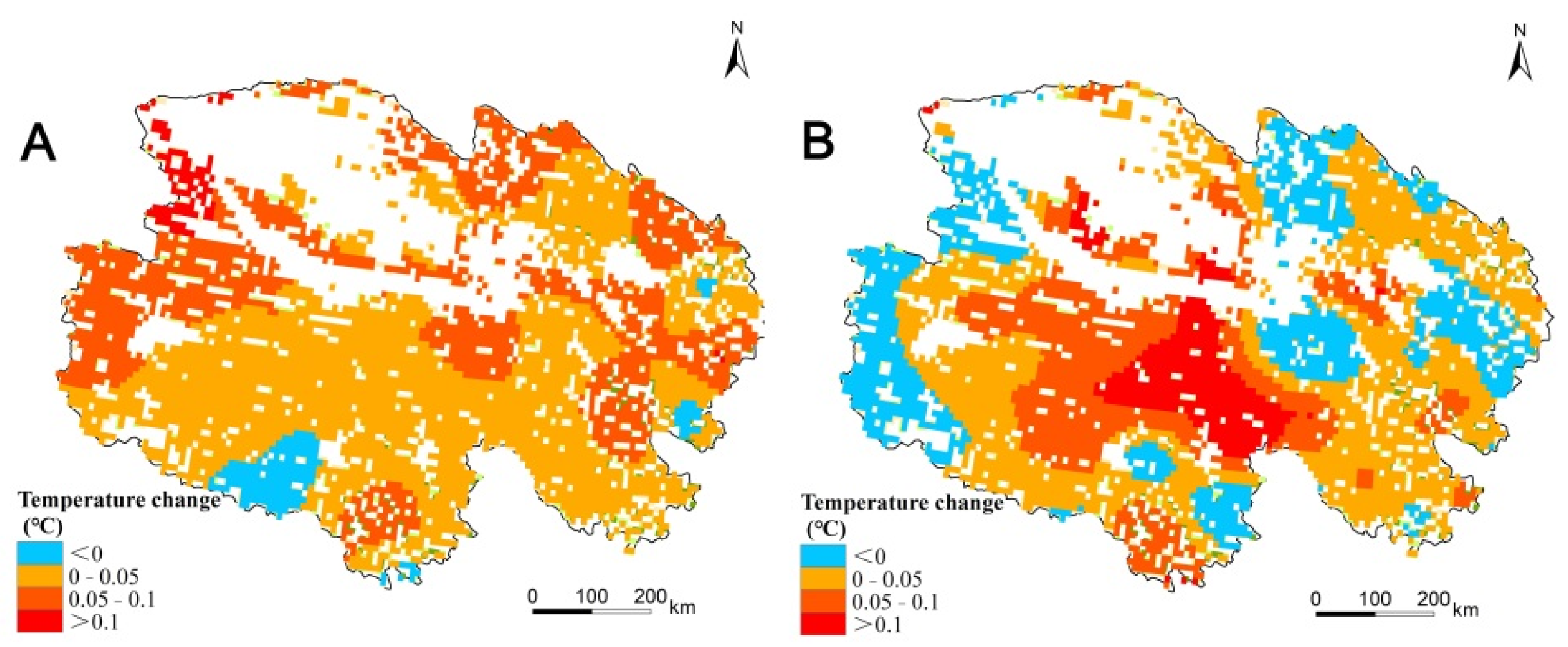

References
- Schuman, G.E.; Janzen, H.H.; Herrick, J.E. Soil carbon dynamics and potential carbon sequestration by rangelands. Environ. Pollut. 2002, 116, 391–396. [Google Scholar] [CrossRef]
- Li, C.; Fultz, L.M.; Moore-Kucera, J.; Acosta-Martinez, V.; Horita, J.; Strauss, R.; Zak, J.; Calderon, F.; Weindorf, D. Soil carbon sequestration potential in semi-arid grasslands in the Conservation Reserve Program. Geoderma 2017, 294, 80–90. [Google Scholar] [CrossRef] [Green Version]
- Wiesmeier, M.; Huebner, R.; Spoerlein, P.; Geuss, U.; Hangen, E.; Reischl, A.; Schilling, B.; von Luetzow, M.; Koegel-Knabner, I. Carbon sequestration potential of soils in southeast Germany derived from stable soil organic carbon saturation. Glob. Chang. Biol. 2014, 20, 653–665. [Google Scholar] [CrossRef] [PubMed]
- Chen, S.; Arrouays, D.; Angers, D.A.; Martin, M.P.; Walter, C. Soil carbon stocks under different land uses and the applicability of the soil carbon saturation concept. Soil Tillage Res. 2019, 188, 53–58. [Google Scholar] [CrossRef]
- Webb, J.R.; Santos, I.R.; Maher, D.T.; Finlay, K. The Importance of Aquatic Carbon Fluxes in Net Ecosystem Carbon Budgets: A Catchment-Scale Review. Ecosystems 2019, 22, 508–527. [Google Scholar] [CrossRef]
- Kristensen, J.A.; Svenning, J.-C.; Georgiou, K.; Malhi, Y. Can large herbivores enhance ecosystem carbon persistence? Trends Ecol. Evol. 2021, 37, 117–128. [Google Scholar] [CrossRef]
- Volkova, L.; Roxburgh, S.H.; Weston, C.J. Effects of prescribed fire frequency on wildfire emissions and carbon sequestration in a fire adapted ecosystem using a comprehensive carbon model. J. Environ. Manag. 2021, 290, 112673. [Google Scholar] [CrossRef]
- Chang, J.; Ciais, P.; Gasser, T.; Smith, P.; Herrero, M.; Havlik, P.; Obersteiner, M.; Guenet, B.; Goll, D.S.; Li, W.; et al. Climate warming from managed grasslands cancels the cooling effect of carbon sinks in sparsely grazed and natural grasslands. Nat. Commun. 2021, 12, 118. [Google Scholar] [CrossRef]
- Legesse, T.G.; Dong, G.; Jiang, S.; Chen, J.; Dong, X.; Daba, N.A.; Sorecha, E.M.; Qu, L.; Tian, L.; Shao, C. Small precipitation events enhance the Eurasian grassland carbon sink. Ecol. Indic. 2021, 131, 108242. [Google Scholar] [CrossRef]
- Lin, B.; Ge, J. Does institutional freedom matter for global forest carbon sinks in the face of economic development disparity? China Econ. Rev. 2021, 65, 101563. [Google Scholar] [CrossRef]
- Wang, J.; Li, Y.; Bork, E.W.; Richter, G.M.; Chen, C.; Shah, S.H.H.; Mezbahuddin, S. Effects of grazing management on spatio-temporal heterogeneity of soil carbon and greenhouse gas emissions of grasslands and rangelands: Monitoring, assessment and scaling-up. J. Clean. Prod. 2021, 288, 125737. [Google Scholar] [CrossRef]
- Madigan, A.P.; Zimmermann, J.; Krol, D.J.; Williams, M.; Jones, M.B. Full Inversion Tillage (FIT) during pasture renewal as a potential management strategy for enhanced carbon sequestration and storage in Irish grassland soils. Sci. Total Environ. 2022, 805, 150342. [Google Scholar] [CrossRef] [PubMed]
- Li, S.; Liu, M.; Adam, J.C.; Pi, H.; Su, F.; Li, D.; Liu, Z.; Yao, Z. Contribution of Snow-Melt Water to the Streamflow over the Three-River Headwater Region, China. Remote Sens. 2021, 13, 1585. [Google Scholar] [CrossRef]
- Li, Z.; Li, Z.; Feng, Q.; Wang, X.; Mu, Y.; Xin, H.; Song, L.-L.; Gui, J.; Zhang, B.; Gao, W.; et al. Hydrological effects of multiphase water transformation in Three-River Headwaters Region, China. J. Hydrol. 2021, 601, 126662. [Google Scholar] [CrossRef]
- Zhou, W.; Yang, H.; Xie, L.; Li, H.; Huang, L.; Zhao, Y.; Yue, T. Hyperspectral inversion of soil heavy metals in Three-River Source Region based on random forest model. Catena 2021, 202, 105222. [Google Scholar] [CrossRef]
- Li, S.; Dong, S.; Shen, H.; Han, Y.; Zhang, J.; Xu, Y.; Gao, X.; Yang, M.; Li, Y.; Zhao, Z.; et al. Different responses of multifaceted plant diversities of alpine meadow and alpine steppe to nitrogen addition gradients on Qinghai-Tibetan Plateau. Sci. Total Environ. 2019, 688, 1405–1412. [Google Scholar] [CrossRef]
- Dong, S.; Li, Y.; Ganjurjav, H.; Gao, Q.; Gao, X.; Zhang, J.; Yan, Y.; Zhang, Y.; Liu, S.; Hu, G.; et al. Grazing promoted soil microbial functional genes for regulating C and N cycling in alpine meadow of the Qinghai-Tibetan Plateau. Agric. Ecosyst. Environ. 2020, 303, 107111. [Google Scholar] [CrossRef]
- Zhou, B.-R.; Wu, L.; Song, M.-H.; Zhou, H.-K.; Li, Y.-K.; Wang, M.; Zhang, T.-J.; Yan, Y.-Q.; Ji, H.-J. Distinct climate driven spatial patterns of frozen soil and vegetation that reflect plant sensitivities across the Tibetan Plateau. Land Degrad. Dev. 2021, 32, 4227–4240. [Google Scholar] [CrossRef]
- Dong, S.; Zhang, J.; Li, Y.; Liu, S.; Dong, Q.; Zhou, H.; Yeomans, J.; Li, Y.; Li, S.; Gao, X. Effect of grassland degradation on aggregate-associated soil organic carbon of alpine grassland ecosystems in the Qinghai-Tibetan Plateau. Eur. J. Soil Sci. 2020, 71, 69–79. [Google Scholar] [CrossRef]
- Li, Y.; Dong, S.; Wen, L.; Wang, X.; Wu, Y. The effects of fencing on carbon stocks in the degraded alpine grasslands of the Qinghai-Tibetan Plateau. J. Environ. Manag. 2013, 128, 393–399. [Google Scholar] [CrossRef]
- Zhang, W.; Zhang, F.; Qi, J.; Hou, F. Modeling impacts of climate change and grazing effects on plant biomass and soil organic carbon in the Qinghai-Tibetan grasslands. Biogeosciences 2017, 14, 5455–5470. [Google Scholar] [CrossRef] [Green Version]
- Tian, H.; Xu, R.; Canadell, J.G.; Thompson, R.L.; Winiwarter, W.; Suntharalingam, P.; Davidson, E.A.; Ciais, P.; Jackson, R.B.; Janssens-Maenhout, G.; et al. A comprehensive quantification of global nitrous oxide sources and sinks. Nature 2020, 586, 248–256. [Google Scholar] [CrossRef] [PubMed]
- Li, C.; Li, Q.; Zhao, L.; Ge, S.; Chen, D.; Dong, Q.; Zhao, X. Land-use effects on organic and inorganic carbon patterns in the topsoil around Qinghai Lake basin, Qinghai-Tibetan Plateau. Catena 2016, 147, 345–355. [Google Scholar] [CrossRef]
- Du, Y.; Zhou, G.; Guo, X.; Cao, G. Spatial distribution of grassland soil organic carbon and potential carbon storage on the Qinghai Plateau. Grassl. Sci. 2019, 65, 141–146. [Google Scholar] [CrossRef]
- Wang, D.; Li, X.; Zou, D.; Wu, T.; Xu, H.; Hu, G.; Li, R.; Ding, Y.; Zhao, L.; Li, W.; et al. Modeling soil organic carbon spatial distribution for a complex terrain based on geographically weighted regression in the eastern Qinghai-Tibetan Plateau. Catena 2020, 187, 104399. [Google Scholar] [CrossRef]
- Zhang, G.; Nan, Z.; Zhao, L.; Liang, Y.; Cheng, G. Qinghai-Tibet Plateau wetting reduces permafrost thermal responses to climate warming. Earth Planet. Sci. Lett. 2021, 562, 116858. [Google Scholar] [CrossRef]
- Zhang, M.; Cheng, Y.; Bao, Y.; Zhao, C.; Wang, G.; Zhang, Y.; Song, Z.; Wu, Z.; Qiao, F. Seasonal to decadal spatiotemporal variations of the global ocean carbon sink. Glob. Chang. Biol. 2021, 28, 1786–1797. [Google Scholar] [CrossRef]
- Abdalla, K.; Mutema, M.; Chivenge, P.; Everson, C.; Chaplot, V. Grassland degradation significantly enhances soil CO2 emission. Catena 2018, 167, 284–292. [Google Scholar] [CrossRef]
- Bardgett, R.D.; Bullock, J.M.; Lavorel, S.; Manning, P.; Schaffner, U.; Ostle, N.; Chomel, M.; Durigan, G.; Fry, E.L.; Johnson, D.; et al. Combatting global grassland degradation. Nat. Rev. Earth Environ. 2021, 2, 720–735. [Google Scholar] [CrossRef]
- Buermann, W.; Forkel, M.; O’Sullivan, M.; Sitch, S.; Friedlingstein, P.; Haverd, V.; Jain, A.K.; Kato, E.; Kautz, M.; Lienert, S.; et al. Widespread seasonal compensation effects of spring warming on northern plant productivity. Nature 2018, 562, 110–114. [Google Scholar] [CrossRef] [Green Version]
- Hoglind, M.; Van Oijen, M.; Cameron, D.; Persson, T. Process-based simulation of growth and overwintering of grassland using the BASGRA model. Ecol. Model. 2016, 335, 1–15. [Google Scholar] [CrossRef] [Green Version]
- Moring, A.; Vieno, M.; Doherty, R.M.; Milford, C.; Nemitz, E.; Twigg, M.M.; Horvath, L.; Sutton, M.A. Process-based modelling of NH3 exchange with grazed grasslands. Biogeosciences 2017, 14, 4161–4193. [Google Scholar] [CrossRef] [Green Version]
- Li, C.; Zhang, C.; Luo, G.; Chen, X.; Maisupova, B.; Madaminov, A.A.; Han, Q.; Djenbaev, B.M. Carbon stock and its responses to climate change in Central Asia. Glob. Chang. Biol. 2015, 21, 1951–1967. [Google Scholar] [CrossRef] [PubMed]
- Huang, X.; Luo, G.; Han, Q. Temporospatial patterns of human appropriation of net primary production in Central Asia grasslands. Ecol. Indic. 2018, 91, 555–561. [Google Scholar] [CrossRef]
- Hidy, D.; Barcza, Z.; Marjanovic, H.; Sever, M.Z.O.; Dobor, L.; Gelybo, G.; Fodor, N.; Pinter, K.; Churkina, G.; Running, S.; et al. Terrestrial ecosystem process model Biome-BGCMuSo v4.0: Summary of improvements and new modeling possibilities. Geosci. Model Dev. 2016, 9, 4405–4437. [Google Scholar] [CrossRef] [Green Version]
- Huang, X.; Chen, C.; Yao, B.; Ma, Z.; Zhou, H. Spatiotemporal Dynamics of the Carbon Budget and the Response to Grazing in Qinghai Grasslands. Front. Plant Sci. 2022, 12, 775015. [Google Scholar] [CrossRef]
- Huang, X.; Liu, J.; Shen, K.; Liu, Y.; Wang, L. Grassland yield change in Qinghai Province based on MODIS data. Arid Land Geogr. 2020, 43, 715–725. [Google Scholar]
- Farquhar, G.D.; Caemmerer, S.V.; Berry, J.A. A biochemical-model of photosynthetic CO2 assimilation in leaves of C-3 species. Planta 1980, 149, 78–90. [Google Scholar] [CrossRef] [Green Version]
- Thornton, P.E.; Rosenbloom, N.A. Ecosystem model spin-up: Estimating steady state conditions in a coupled terrestrial carbon and nitrogen cycle model. Ecol. Model. 2005, 189, 25–48. [Google Scholar] [CrossRef]
- Running, S.W.; Coughlan, J.C. A general-model of forest ecosystem processes for regional applications.1. hydrologic balance, canopy gas-exchange and primary production process. Ecol. Model. 1988, 42, 125–154. [Google Scholar] [CrossRef]
- He, J.; Yang, K.; Tang, W.; Lu, H.; Qin, J.; Chen, Y.; Li, X. The first high-resolution meteorological forcing dataset for land process studies over China. Sci. Data 2020, 7, 25. [Google Scholar] [CrossRef] [PubMed] [Green Version]
- White, M.; Thornton, P.E.; Running, S.W.; Nemani, R.R. Parameterization and sensitivity analysis of the BIOME–BGC terrestrial ecosystem model: Net primary production controls. Earth Interact. 2000, 4, 1–85. [Google Scholar] [CrossRef]
- Li, Y.-Y.; Dong, S.-K.; Wen, L.; Wang, X.-X.; Wu, Y. Soil carbon and nitrogen pools and their relationship to plant and soil dynamics of degraded and artificially restored grasslands of the Qinghai-Tibetan Plateau. Geoderma 2014, 213, 178–184. [Google Scholar] [CrossRef]
- Laub, M.; Ali, R.S.; Demyan, M.S.; Nkwain, Y.F.; Poll, C.; Hogy, P.; Poyda, A.; Ingwersen, J.; Blagodatsky, S.; Kandeler, E.; et al. Modeling temperature sensitivity of soil organic matter decomposition: Splitting the pools. Soil Biol. Biochem. 2021, 153. [Google Scholar] [CrossRef]
- Zhang, Y.; Zhang, C.; Wang, Z.; Yang, Y.; Zhang, Y.; Li, J.; An, R. Quantitative assessment of relative roles of climate change and human activities on grassland net primary productivity in the Three-River Source Region, China. Acta Prataculturae Sin. 2017, 26, 1–14. [Google Scholar]
- Dai, L.; Fu, R.; Guo, X.; Du, Y.; Lin, L.; Zhang, F.; Li, Y.; Cao, G. Long-term grazing exclusion greatly improve carbon and nitrogen store in an alpine meadow on the northern Qinghai-Tibet Plateau. Catena 2021, 197, 108108. [Google Scholar] [CrossRef]
- Gao, X.; Dong, S.; Li, S.; Xu, Y.; Liu, S.; Zhao, H.; Yeomans, J.; Li, Y.; Shen, H.; Wu, S.; et al. Using the random forest model and validated MODIS with the field spectrometer measurement promote the accuracy of estimating aboveground biomass and coverage of alpine grasslands on the Qinghai-Tibetan Plateau. Ecol. Indic. 2020, 112, 106114. [Google Scholar] [CrossRef]
- Xiong, Q.; Xiao, Y.; Liang, P.; Li, L.; Zhang, L.; Li, T.; Pan, K.; Liu, C. Trends in climate change and human interventions indicate grassland productivity on the Qinghai-Tibetan Plateau from 1980 to 2015. Ecol. Indic. 2021, 129, 108010. [Google Scholar] [CrossRef]
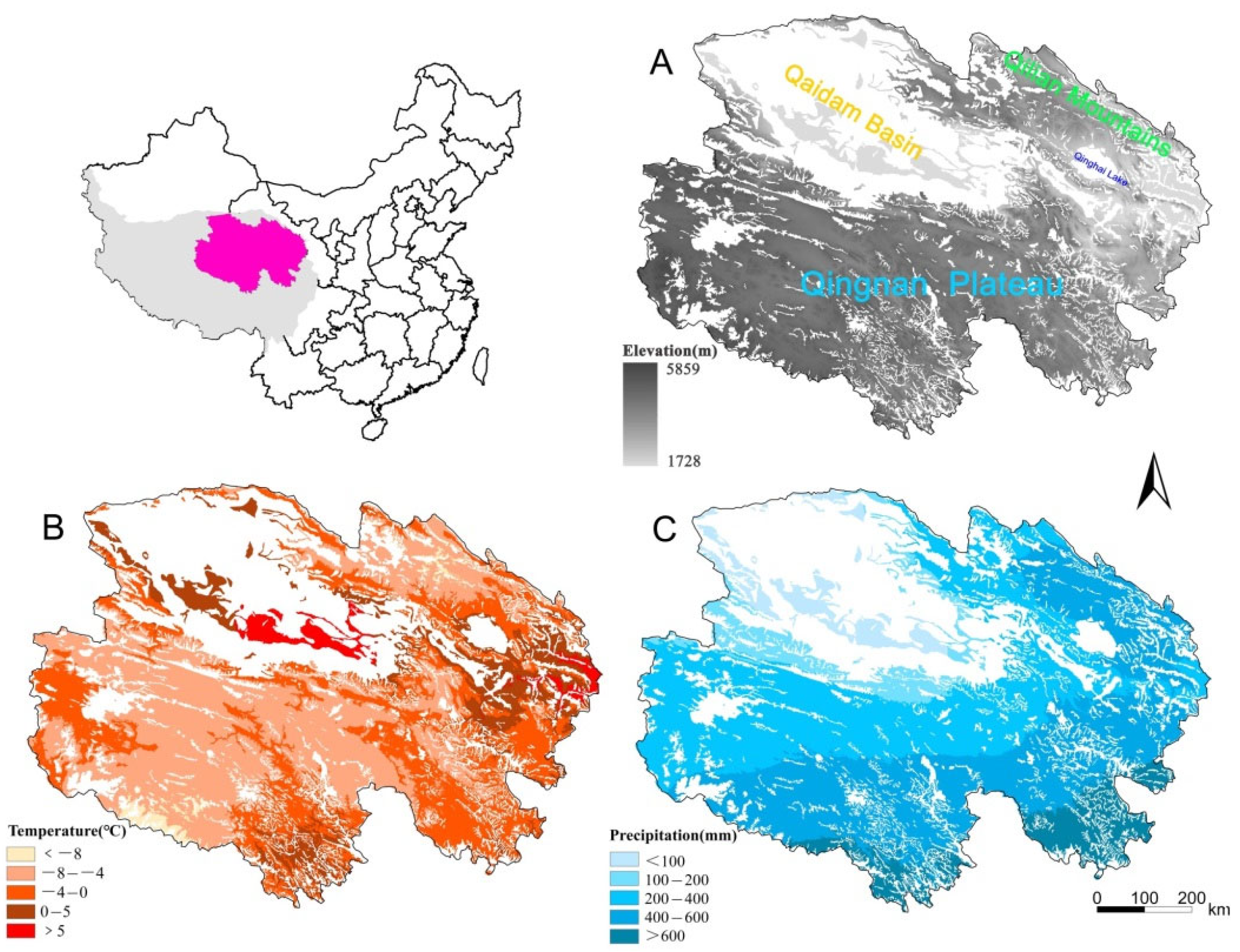
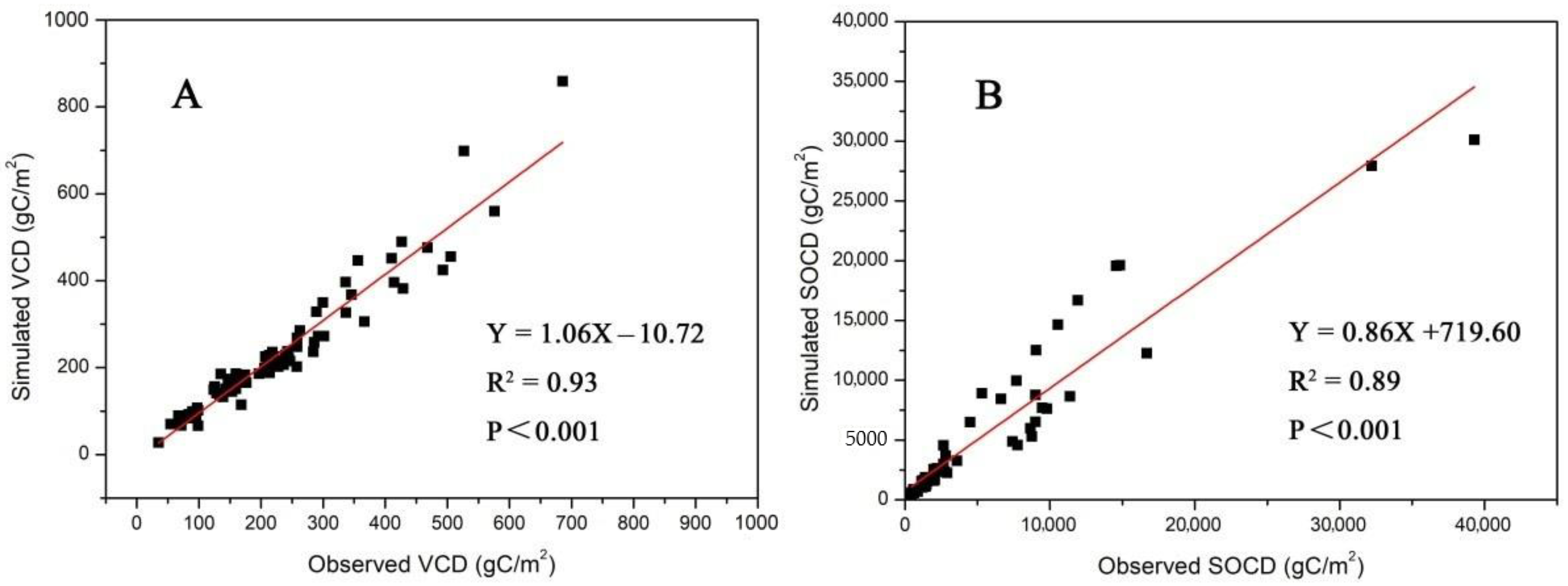

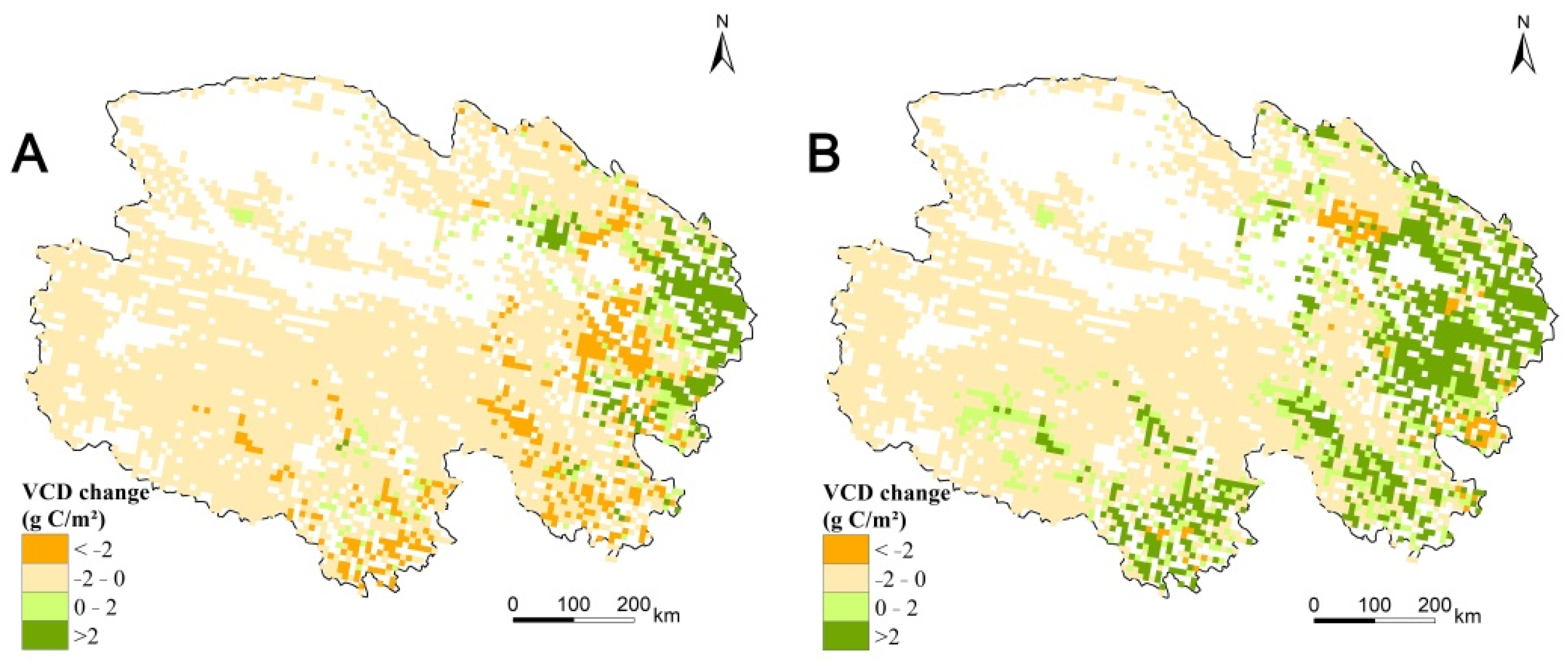

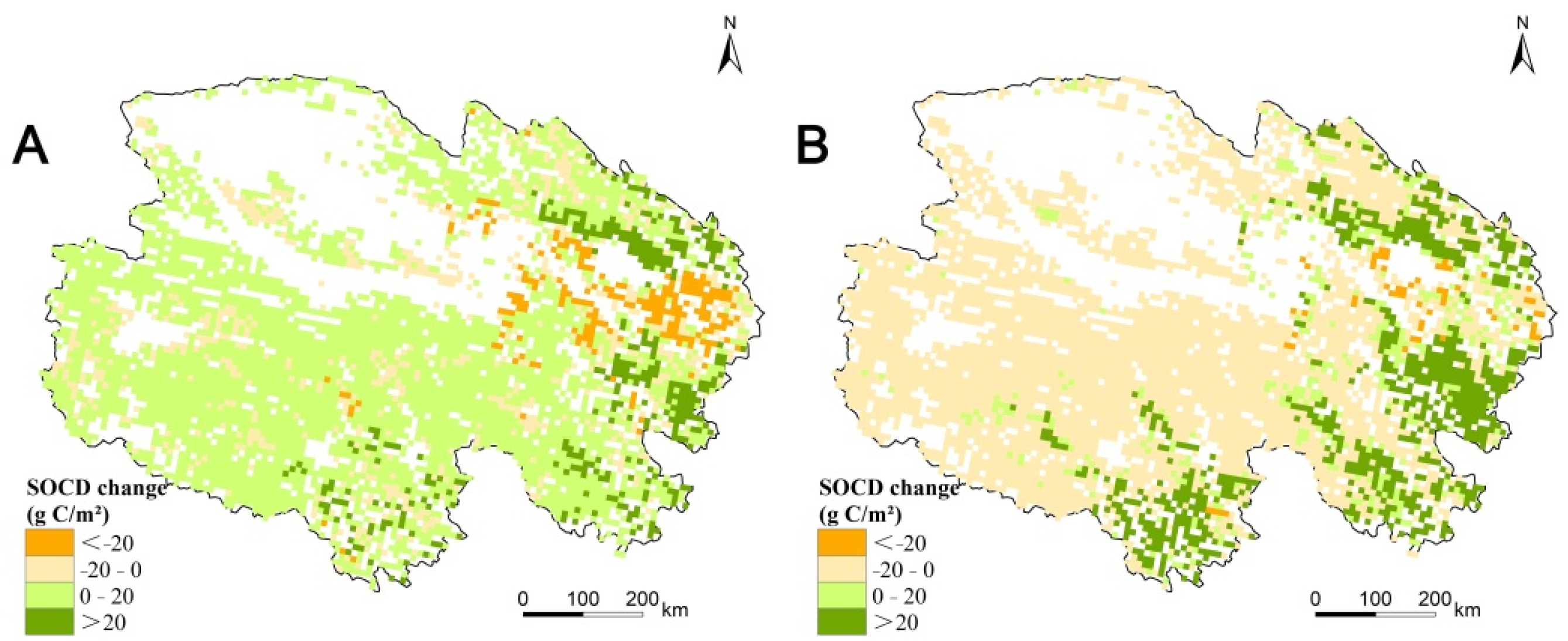
Publisher’s Note: MDPI stays neutral with regard to jurisdictional claims in published maps and institutional affiliations. |
© 2022 by the authors. Licensee MDPI, Basel, Switzerland. This article is an open access article distributed under the terms and conditions of the Creative Commons Attribution (CC BY) license (https://creativecommons.org/licenses/by/4.0/).
Share and Cite
Huang, X.; Yao, B.; Liu, X.; Chen, C. Temporal and Spatial Dynamics of Carbon Storage in Qinghai Grasslands. Agronomy 2022, 12, 1201. https://doi.org/10.3390/agronomy12051201
Huang X, Yao B, Liu X, Chen C. Temporal and Spatial Dynamics of Carbon Storage in Qinghai Grasslands. Agronomy. 2022; 12(5):1201. https://doi.org/10.3390/agronomy12051201
Chicago/Turabian StyleHuang, Xiaotao, Buqing Yao, Xiang Liu, and Chunbo Chen. 2022. "Temporal and Spatial Dynamics of Carbon Storage in Qinghai Grasslands" Agronomy 12, no. 5: 1201. https://doi.org/10.3390/agronomy12051201
APA StyleHuang, X., Yao, B., Liu, X., & Chen, C. (2022). Temporal and Spatial Dynamics of Carbon Storage in Qinghai Grasslands. Agronomy, 12(5), 1201. https://doi.org/10.3390/agronomy12051201






